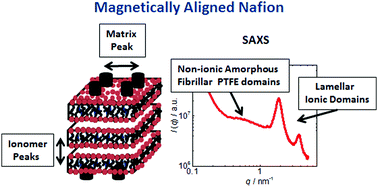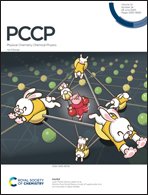SAXS signature of the lamellar ordering of ionic domains of perfluorinated sulfonic-acid ionomers by electric and magnetic field-assisted casting†
Abstract
At present, small angle X-ray scattering (SAXS) studies of perfluorinated sulfonic-acid ionomers (PFSAs) are unable to fully determine the true shape of their building blocks, as recent SAXS modelling predicts disk- and rod-like nanoionic domains as being equally possible. This scenario requires evidence-based findings to unravel the real shape of PFSA building blocks. Herein, a SAXS pattern signature for a lamellar nanophase separation of the ionic domains of Nafion is presented, backed by mid and far infrared spectroscopy (MIR and FIR) and wide angle X-ray scattering (WAXS) data of Nafion in different ionic forms, a broad range of ionic phase contents (EW ∼ 859–42 252 g eq−1) and temperatures. The study indicates that the lamellar arrangement of the ionic domains is the most representative morphology that accounts for the physical properties of this ionomer. The lamellar SAXS reflections of Nafion are enhanced in electric and magnetic field-aligned membranes, as confirmed by atomic force microscopy (AFM). Electric and magnetic field-assisted casting of Nafion allowed producing nanostructured and anisotropic films with the lamellas stacked perpendicularly to the field vector, which is the direction of interest for several applications. Such nanostructured Nafion membranes are bestowed with advanced optical and proton transport properties, making them promising materials for solar and fuel cells.



 Please wait while we load your content...
Please wait while we load your content...